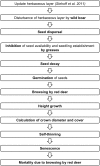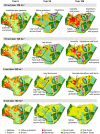Modeling Wood Encroachment in Abandoned Grasslands in the Eifel National Park - Model Description and Testing
- PMID: 25494057
- PMCID: PMC4262262
- DOI: 10.1371/journal.pone.0113827
Modeling Wood Encroachment in Abandoned Grasslands in the Eifel National Park - Model Description and Testing
Abstract
The degradation of natural and semi-natural landscapes has become a matter of global concern. In Germany, semi-natural grasslands belong to the most species-rich habitat types but have suffered heavily from changes in land use. After abandonment, the course of succession at a specific site is often difficult to predict because many processes interact. In order to support decision making when managing semi-natural grasslands in the Eifel National Park, we built the WoodS-Model (Woodland Succession Model). A multimodeling approach was used to integrate vegetation dynamics in both the herbaceous and shrub/tree layer. The cover of grasses and herbs was simulated in a compartment model, whereas bushes and trees were modelled in an individual-based manner. Both models worked and interacted in a spatially explicit, raster-based landscape. We present here the model description, parameterization and testing. We show highly detailed projections of the succession of a semi-natural grassland including the influence of initial vegetation composition, neighborhood interactions and ungulate browsing. We carefully weighted the single processes against each other and their relevance for landscape development under different scenarios, while explicitly considering specific site conditions. Model evaluation revealed that the model is able to emulate successional patterns as observed in the field as well as plausible results for different population densities of red deer. Important neighborhood interactions such as seed dispersal, the protection of seedlings from browsing ungulates by thorny bushes, and the inhibition of wood encroachment by the herbaceous layer, have been successfully reproduced. Therefore, not only a detailed model but also detailed initialization turned out to be important for spatially explicit projections of a given site. The advantage of the WoodS-Model is that it integrates these many mutually interacting processes of succession.
Conflict of interest statement
Figures















References
-
- CBD (2010) Fourth National Report under the Convention on Biological Diversity (CBD) – Germany. Available: http://www.cbd.int/reports/search/.
-
- Poschlod P, Bakker JP, Kahmen S (2005) Changing land use and its impact on biodiversity. Basic and Applied Ecology 6:93–98.
-
- GBO3 (2010) Secretariat of the Convention on Biological Diversity. Global Biodiversity Outlook 3– Executive Summary. Montreal.
-
- Lind B, Stein S, Kärcher A, Klein M (2009) Where have all the flowers gone? Grünland im Umbruch. Bonn: German Federal Agency for Nature Conservation (BfN).
-
- EU-COM. Composite Report on the Conservation Status of Habitat Types and Species as required under Article 17 of Habitats Directive, Report from the Commission to the Council and the European Parliament. COM (2009) 358 final; 2009; Brussels.
Publication types
MeSH terms
LinkOut - more resources
Full Text Sources
Other Literature Sources

